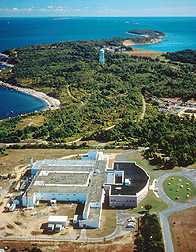
Biosafety Bites #3 (6 July 2004)
Moribund: The Department of Homeland Security's Plum Island Biosafety Committee
According to the Bush administration's senior science policy officials, the way to address the problems posed by ever more aggressive US research on biological weapons agents is not to regulate laboratories but to turn the matter over to institutional biosafety committees, the local bodies that review research safety. These voluntary committees, the administration argues, have a culture of responsibility that will ensure that dual-use research with biological weapons agents doesn’t go awry. So it follows that at facilities such as those of the Department of Homeland Security (DHS), if anywhere, a robust and effective institutional biosafety committee system should be found. That is not the case.
Few, if any, biodefense research facilities have had as controversial a relationship with neighbors as the Plum Island Animal Disease Center, a large biosafety level three lab located on a small island in New York. In the Long Island Sound between New York and Connecticut shores, Plum Island was originally slated to be a US Army chemical weapons lab. In the 1950s, however, it passed to the US Department of Agriculture and became USDA's primary research lab on exotic animal diseases, such as African swine fever and foot and mouth disease. In 1999 and again in 2002, USDA tried to upgrade Plum Island to biosafety level four. Each time, the USDA was stymied by local opposition that has been remarkably effective at mobilizing its elected officials' influence in Washington.
Things are changing, however, and on June 1st, 2003, Plum Island got a new owner. Since assuming control, the US Department of Homeland Security (DHS) has been coy about its plans, saying that it does not plan a BSL-4; but that Plum Island has a significant role in DHS's highly controversial biological weapons "threat characterization" agenda.
Recently, DHS revealed that Plum Island will be renovated and re-christened as the Department's Agricultural Biodefense Center (ABC).
On the face of it, DHS says it is "committed to positive community relations;" but in a recently-published notice in the Federal Register, it proposed to grant itself authority to make secret the environmental assessments of government activities that are required by the National Environmental Policy Act (NEPA). The change would make it possible for DHS to conduct activities on Plum Island (and other facilities) without divulging risks, effects or even their existence under NEPA. Plum Island is poised on the bleeding edge of DHS's research program on biological weapons, a program that includes activities that independent observers conclude are practically indistinguishable from offensive biological weapons research.
Which brings us back to Plum Island's institutional biosafety committee (IBC), the local committee that, according to the Bush administration, forms the government's major line of defense to review dual-use research projects and to ensure their safety and security. Thus, if there is a place where the government might demonstrate that IBCs can in fact be an effective mechanism to review the conduct of dual-use bioweapons research, it is at facilities like Plum Island, which are under direct government control and which have missions that are focused on biodefense.
What has DHS done with the Plum Island Institutional Biosafety Committee? Nothing. Since DHS took over the facility more than a year ago, the Plum Island IBC has not met. Not once. The committee whose responsibility it is to ensure that research is safe and secure appears to be moribund. Not only has there been no committee review of Plum Island's new and ongoing research projects, the committee has not met to review safety conditions in laboratories nor to perform any of the other duties incumbent upon it.
Bush administration biodefense policy leaders claim that IBCs can take responsibility for the conduct of dual-use research with biological weapons agents; but the Department of Homeland Security itself does not maintain an effective institutional biosafety committee at Plum Island.







No comments:
Post a Comment